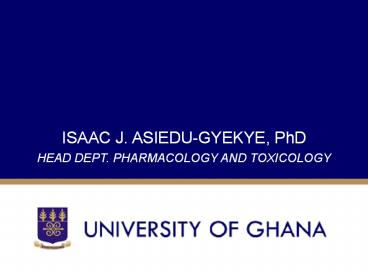ISAAC%20J.%20ASIEDU-GYEKYE,%20PhD
Title:
ISAAC%20J.%20ASIEDU-GYEKYE,%20PhD
Description:
isaac j. asiedu-gyekye, phd head dept. pharmacology and toxicology –
Number of Views:393
Avg rating:3.0/5.0
Title: ISAAC%20J.%20ASIEDU-GYEKYE,%20PhD
1
- ISAAC J. ASIEDU-GYEKYE, PhD
- HEAD DEPT. PHARMACOLOGY AND TOXICOLOGY
2
A TOXICOLOGICAL STUDY INTO NEW MOLECULES FOR
TREATING RAW WATER TO MAKE IT POTABLE
- UNIVERSITY OF GHANA SCHOOL OF PHARMACY
3
INTRODUCTION
- Chemical based disinfectant of the polymeric
guanidine family. - Potent virucide and in vitro bactericide.
- Odorless, non-corrosive, and has been shown to be
non-toxic in an in vitro cytotoxicity study
involving low concentrations (0.04 and 0.005
w/v).
4
INTRODUCTION
- Highly soluble in water.
- PHMGH is also used as an effective sporicidal
disinfectant. - In an in vitro study
- killed all spores at a concentration
corresponding to 0.52 (w/v) within 90 s of
contact and 0.36 (w/v) for 3 min.
5
INTRODUCTION
- Current recommendation of PHMGH
- as bactericidal and fungicidal disinfectant for
the treatment of harvested cocoa beans - cooling systems
- for the treatment of raw water to make it potable
(ie good for drinking without fear of poisoning
or disease).
6
INTRODUCTION
- Current water treatment in Ghana.
- Regulatory concerns .
- Administration of PHMGH in both rats and humans
have been associated with the potential for
hepatic, renal gastro-intestinal tract (GIT) and
lung effects. - August 2006 to May 2007 , more than 12,500
patients were admitted to hospital with a history
of drinking illegal cheap vodka in 44 different
regions in Russia, of whom 9.4 died. - ethanol (93), diethyl phthalate, and 0.10.14
PHMGH (Extrasept-1)9
7
ACUTE TOXICITY STUDIES
- Initial administration of 3000 mg/kg in one rat
and 400 mg/kg in another rat. - Thereafter, doses of 8.0 mg/kg, 400 mg/kg, 600
mg/kg, 2000 mg/kg and 3000 mg/kg were
administered in order to determine 50 death of
the animals at the doses tested.
8
SUB-CHRONIC TOXICITY STUDIES
- Group 1 0.006 mg/kg (ie 1.5 mg/L)
- Group 2 0.012 mg/kg (ie 3.0 mg/L)
- Group 3 0.036 mg/kg (ie 9.0 mg/L)
- Control Deionized water
- Automated hematology analyzer KX-2IN, Sysmex
Corporation, Japan) - 2 mg/kg, 8 mg/kg, 32 mg/kg and 40 mg/kg of PHMB.
9
Statistical Analysis
- Graphpad Prism 5. Means SEM were determined for
quantitative variables. - Analysis of variance (ANOVA)
- determine statistical significance invariables
among the groups at p-values 0.05. This was used
for the subchronic studies - unpaired t-test was used for the analysis of the
acute toxicity study results.
10
(No Transcript)
11
(No Transcript)
12
(No Transcript)
13
(No Transcript)
14
(No Transcript)
15
HISTOPATHOLOGICAL STUDIES
- Microscopic evidence showed
- mild hepatocellular necrosis in 10 of animals at
all dose levels administered. - mild tubular damage in 20 of animals (0.012
mg/kg and 0.036 mg/kg). - mild myocarditis in 10 of animals (0.006 mg/kg).
- Manufacturer recommends a dose of 0.012 mg/kg bwt
(3.0 mg/L) to be used for water treatment
process.
16
(No Transcript)
17
CONCLUSION
- According to other studies conducted, the LD50 to
minimal working dose ratio of PHMGH lies between
50-126 - average cumulative toxicity.
- Our acute study results also did not confirm such
a claim since our LD50 of 600 mg/kg to the
manufacturers working dose of 0.012 mg/kg lies
beyond this range.
18
Conclusion
- Median lethal dose (LD50) to be 600 mg/kg of
PHMGH and 16 mg/kg PHMB. - Subchronic toxicological studies not associated
with mortality or visible clinical signs of
toxicity. - No observable anomalies in the hematological and
biochemical parameters utilized to evaluate liver
function, kidney function, and lipid profiles.
19
REFERENCES
- Oulé MK, Azinwi R, Bernier AM, Kablan T,
Maupertuis AM, Mauler S, Nevry RK, Dembélé K,
Forbes L, Diop L. Polyhexamethylene guanidine
hydrochloride-based disinfectant a novel tool to
fight meticillin-resistant Staphylococcus aureus
and nosocomial infections. J Med Microbiol. 2008
57(Pt 12)1523-8. doi 10.1099/jmm.0.2008/003350-0
. - Oulé MK, Quinn K, Dickman M, Bernier AM, Rondeau
S, De Moissac D, Boisvert A, Diop L. Akwaton,
polyhexamethylene-guanidine hydrochloride-based
sporicidal disinfectant a novel tool to fight
bacterial spores and nosocomial infections. J Med
Microbiol. 2012 61(Pt 10)1421-7. doi
10.1099/jmm.0.047514-0. Epub 2012 Aug 7.
20
REFERENCES
- Kusnetsov JM, Tulkki AI, Ahonen HE, Martikainen
PJ. Efficacy of three prevention strategies
against legionella in cooling water systems. J
Appl Microbiol. 1997 82 763768.
CrossRefMedline. - Mathurin YK, Koffi-Nevry R, Guéhi ST, Tano K,
Oulé MK. Antimicrobial activities of
polyhexamethylene guanidine hydrochloride-based
disinfectant against fungi isolated from cocoa
beans and reference strains of bacteria. J Food
Prot. 2012 75(6)1167-71. doi
10.4315/0362-028X.JFP-11-361. - Frayne Colin. The Selection and Application of
Nonoxidizing Biocides for Cooling Water Systems.
The Analyst, the voice of the water treatment
industry, 2001 5.
21
REFERENCES
- Background Document to the opinion proposing
harmonised classification and labelling at
Community level of Polyhexamethylene biguanide or
Poly(hexamethylene) biguanide hydrochloride or
PHMB ECHA/RAC/CLH-O-0000001973-68-01/A1,
September 2011. http//echa.europa.eu/documents/10
162/2125cf0b-8320-48fc-b213-2f4fe29e3d38 - Ostapenko YN, Brusin KM, Zobnin YV, Shchupak AY,
Vishnevetskiy MK, Sentsov VG, Novikova OV,
Alekseenko SA, Lebed'Ko OA, Puchkov YB. Acute
cholestatic liver injury caused by
polyhexamethyleneguanidine hydrochloride admixed
to ethyl alcohol, Critical care toxicology,2011
496471-477. doi10.3109/15563650.2011.592837. - Ministry Of Health of Russian Federation. Report
on Research Work Experimental Estimation of
Maximal Permitted Concentration of
Polyhexamethylene Guanidine Hydrochloride (PHMG)
In Aquatiq Environment Sechenov Moscow Medical
Academy, Moscow, 1993 3-5. www.teflexvissac.com/s
hop/board/download.php?idreportno.
22
REFERENCES
- Greaves P. Histopathology of preclinical toxicity
studies Interpretation and Relevance in Drug
Safety Evaluation. 2007. 3rd ed. New York
Academic Press. - Kim JY, Kim HH, Cho KH. Acute cardiovascular
toxicity of sterilizers, PHMG, and PGH severe
inflammation in human cells and heart failure in
zebrafish. Cardiovasc Toxicol. 2013
13(2)148-60. doi 10.1007/s12012-012-9193-8. - Jung HN, Zerin T, Podder B, Song HY, Kim YS.
Cytotoxicity and gene expression profiling of
polyhexamethylene guanidine hydrochloride in
human alveolar A549 cells. Toxicol. in Vitro.
2014 28 684692.
23
FOR YOUR ATTENTION
- THANK YOU

